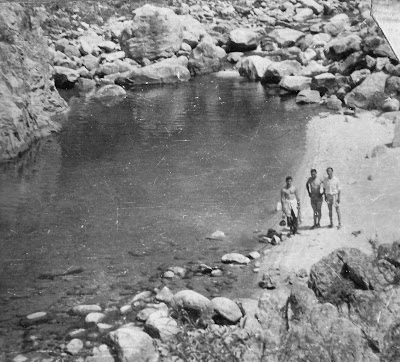While the first drop of the advance team of JACKAL was happening, Captain Zarembo was sent to Kunming for supplies for the team. From the Team Log started by Zarembo, quoted on MMB 55:
" . . . One week later I returned, much worse for wear and tear but with the supplies firmly clutched to my military bosom - two C-47s loaded with containers, all packed and ready for JACKAL's second drop of men and supplies . . . "
The C-47 Skytrain was modified from the civilian Douglas DC-3 for military use "being fitted with a cargo door, hoist
attachment and strengthened floor - along with a shortened tail cone for
glider-towing shackles, and an astrodome in the cabin roof." The C-53 came along a bit later; it was bigger, with greater capacity. But the C-47 had a couple of advantages: it could do with a shorter runway, and American industry produced a lot of them:
"More than 10,000 aircraft were produced in Long Beach and Santa Monica, California, and Oklahoma City, Oklahoma. Between March 1943 and August 1945, the Oklahoma City plant produced 5,354 C-47s."
These were the planes of the Flying Tigers, of flying The Hump, and of the Berlin Airlift.
From the American Airpower Museum:
The airplane had a crew of 4 and deluxe cabin accomodation, as we have already seen. Here is a shiny cargo bay from one they have at
Hendon Aerodrome.
So Cyr, Chu, Friele, Robichaud, and Welo on landing dealt with smashed rifles, smashed cameras, Welo's smashed-up leg, and reports of multitudes of Japanese search parties detailed to look for them, so that "out of twenty consecutive days" they must make "fourteen daily moves." All around were Japanese troops, Chinese troops, Chinese Puppets-of-the-Japanese troops, and Chinese troops who don Puppet uniforms to go mingle with the CPoJ troops, in emulation of their commander Sun Ping-Ying, publicly a Puppet, but secretly not, sort of like the Scarlet Pimpernel but with a different style of poetry.
Cyr traveled by means of a closed-in, horse-drawn cart to meet with Sun Ping-Ying in Hsinhsiang/Xinxiang. We have seen a cart like that in a photo on Photobook Page 17:
The SCR-694 radio mentioned on MMB 65 as being repaired by Welo and Friele is a kind we have seen before.
Want one? They are available.
This advance team came to an understanding with Sun Ping-Ying about chain of command with the First War Area and the Americans; they agreed that all would wait and strike together according to an agreed-upon plan; they reconnoitered some potential targets in the city.
Finally, they began to understand and get used to the psychological situation. In Europe as Jedburghs they had fought alongside "resistance groups that had feelings of patriotism in fighting for their countries against the Germans. Chinese resistance was motivated by individual hatred toward the Japanese invaders for their barbaric and savage treatment of the populace, and not for . . . their country, China, which wasn't really an effective country organization or entity at all because of the Civil War in progress." (MMB 66) That reads to me as a requirement for them to go without hearing the signals of national patriotism to which they were accustomed, and learn to concentrate on an array of different-sounding signals, to make possible after all their mutual goal.
Will the signal-to-noise ratio be constant, or even knowable?
































































